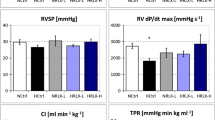We studied the effect of a single session of hyperbaric oxygenation on the size of risk, ischemic, and necrotic zones in rat myocardium after irreversible occlusion of the coronary artery and excessive oxygen pressure of 0.02 and 0.1 MPa. Myocardium infarction was reproduced by ligation of the left coronary artery. The size of the risk, ischemic, and necrotic zones was planimetrically evaluated. Hyperbaric oxygenation (60-min session) was performed 3 h after artery occlusion at excessive oxygen pressure of 0.02 and 0.1 MPa. In rats not exposed to hyperbaric oxygenation, the risk zone median was 31.7% of the left ventricle weight, while after the session it did not exceed 25%. In spontaneous course of myocardium infarction, the ischemia to necrosis zone ratio was 1.7:1, while under conditions of hyperbaric oxygenation at oxygen pressure of 0.1 and 0.02 MPa, the these values were 0.6:1 and 2:1, respectively. Excessive oxygen pressure of 0.02 mPa is better than traditionally used 0.1 MPa, because it promotes redistribution of the ischemic and necrotic areas in the risk zone: the area of necrotic zone decreased at the expense of the ischemic zone. Hyperbaric oxygenation produces a positive effect on the myocardium under conditions of total occlusion of the coronary artery.
Similar content being viewed by others
References
Handbook on Hyperbaric Medicine, Ed. D. Mathieu, [Russian translation], Moscow (2009).
N. A. Zakharova, Bull. Exp. Biol. Med., 46, No. 6, 1454-1457 (1958).
A. N. Leonov, Hyperoxia, Adaptation, Sanogenesis [in Russian], Voronezh (2006).
S. A. Pataraya, Vopr. Giperbarich. Med., 27, No. 1, 28-30 (2006).
G. Asano, E. Takashi, T. Ishiwata, et al., J. Nippon Med., 70, No. 5, 384-392 (2003).
M. H. Bennett, J. P. Lehm, and N. Jepson, Cochrane Database Syst. Rev. No. 8, doi: 10.1002/14651858.CD004818 (2011)
L. dos Santos, A. J. Serra, E. L. Antonio, et al., Clin. Exp. Pharmacol. Physiol., 36, No. 5, 594-598 (2009).
S. Kim, T. Yukishita, K. Lee, et al., Health, 3, No. 7, 432-436 (2011).
M. T. Vivaldi, R. A. Kloner, and F. J. Schoen, Am. J. Pathol., 121, No. 3, 522-530 (1985).
J. Ye, L. Yang, R. Sethi, et al., Mol. Cell. Biochem., 176, Nos. 1-2, 227-233 (1997).
Author information
Authors and Affiliations
Corresponding author
Additional information
Translated from Byulleten’ Eksperimental’noi Biologii i Meditsiny, Vol. 158, No. 12, pp. 692-695, December, 2014
Rights and permissions
About this article
Cite this article
Dotsenko, E.A., Nikulina, N.V., Salivonchik, D.P. et al. Low Doses of Hyperbaric Oxygenation Effectively Decrease the Size of Necrotic Zone in Rats with Experimental Myocardial Infarction. Bull Exp Biol Med 158, 732–734 (2015). https://doi.org/10.1007/s10517-015-2849-1
Received:
Published:
Issue Date:
DOI: https://doi.org/10.1007/s10517-015-2849-1




